Back
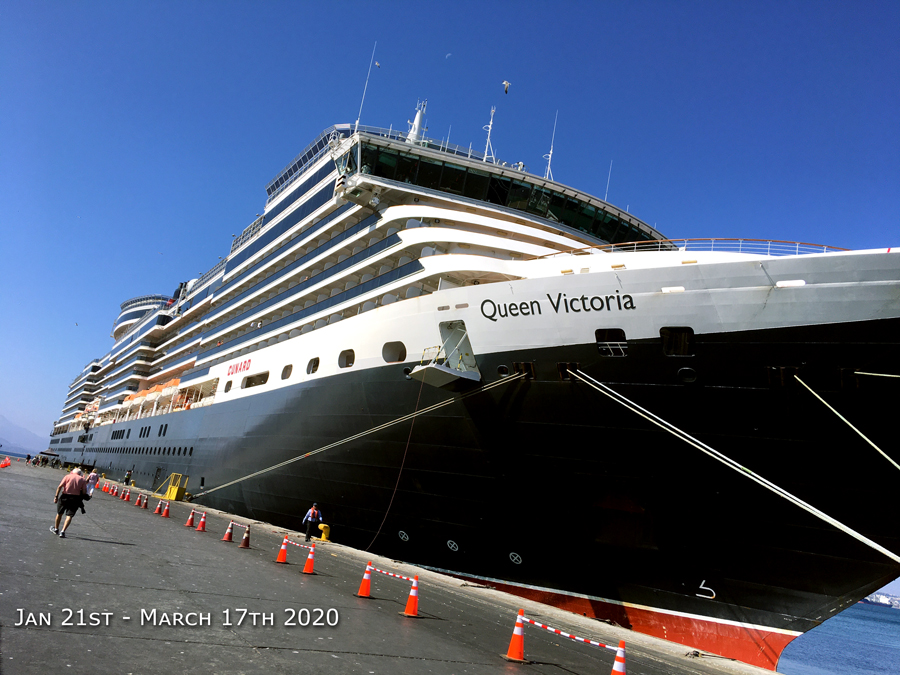
Greetings,
Isolation blues. This January I completed 20 years of running around the country practicing my new profession. I would spend between 275 and 300 nights in hotels each year. The last three years I spent some time on cruises. When the cruise ended I would jump right back into traveling with the same home/hotel ratio. Now I am experiencing a big change. If I start to show withdrawal symptoms Billye said she would deal me some cards.
Page One: Cruising South - Atlantic Ocean side
|
|
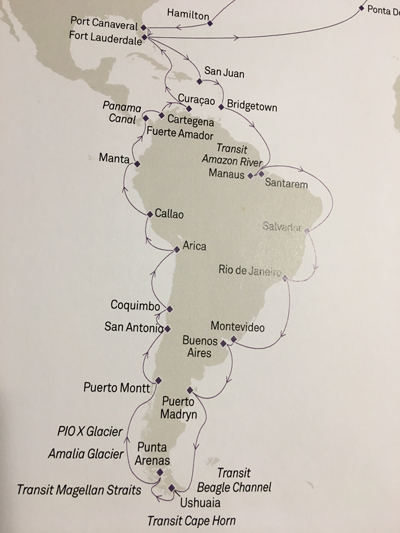
This latest cruise took us around South America. It had added excitement because of the virus. Facebook is not my thing so I thought I would share a few of the highlights here. We embarked from Fort Lauderdale on Jan 21st. The virus was reported only in Wuhan with ten deaths and 200 cases. We returned on Mar 17th, for a total of 56 nights. Rumors abounded but we were told if we had one case of virus on board we would be quarantined. With 2,000 passengers and 1,200 crew the expression " only as strong as it's weakest link" had real meaning.
Our cabin was above the A in Cunard. Billye is holding a towel over the balcony in both ship pictures.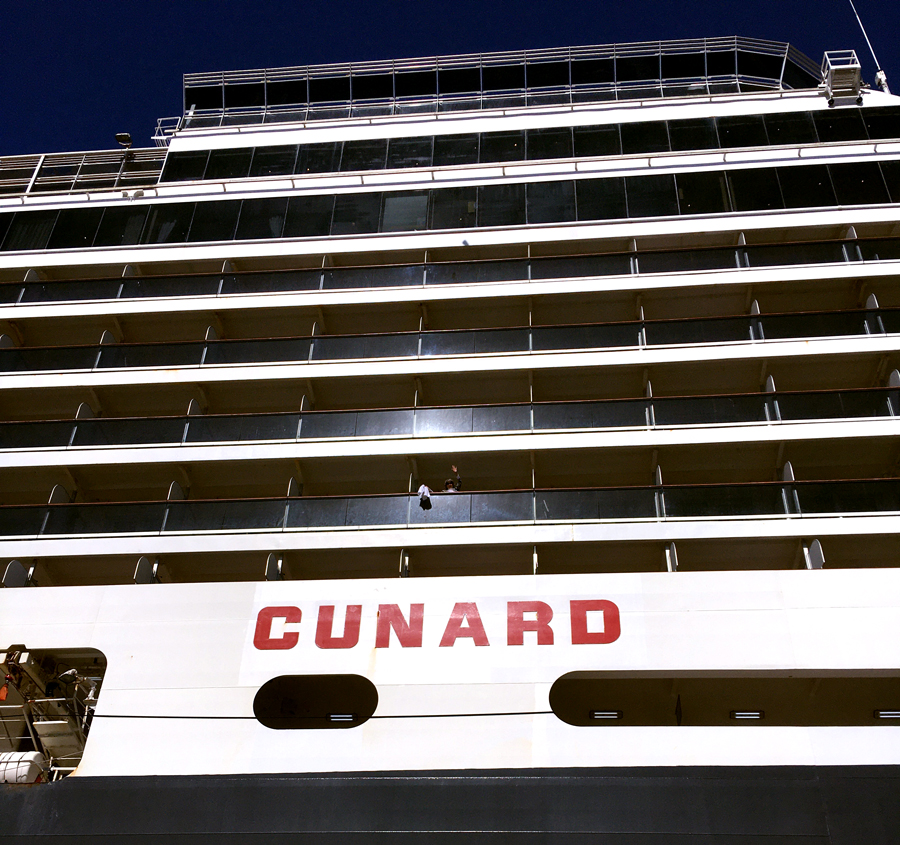
We boarded about noon and unpacked. We were assigned a dinner table and table mates for the trip. This is changeable of course. Our primo table was at the very back of the ship. Great views but background light made pictures difficult.
Sitting across from Billye was Eberhart (82) and to my left was Frankie(80). They were from Germany. He was a heart surgeon. ( He did the first heart transplant in Germany.) She was a teacher. They spoke excellent English and were most friendly and courteous. For the last twelve years they averaged about nine months per year on a cruise. Almost all on a Cunard ship. They have done this trip four times. Round trip from Hamburg makes it an 80 day voyage. 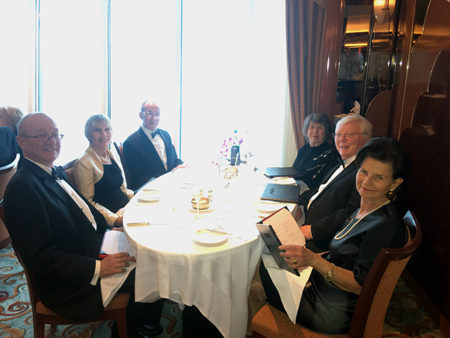 The other couple was Steve(70) and Sue(72)...no joke. They were from England. She was in banking. He ran the farm that had been in the family for multi generations. They live in the original farm house that was built in 1610. It is a cute little two story cottage built of stone. About 30 years ago they added a one story kitchen and an office area on either side. The original root cellar is still used for keeping their food cool.
Steve raises cattle and sheep. Grass fed. No chemicals used anywhere so they have a very sought after organic product. He takes his livestock to a specialty slaughter house where it is sold to high end London restaurants. He is just a good old boy. He can do plumbing, electrical, welding and a lot of veterinary stuff himself. All his fences are made of stone. If they need repair you just don't pile on stones. I learned there is a science to it. They are like us and have just started cruising in the last three years. All Cunard ships. The other couple was Steve(70) and Sue(72)...no joke. They were from England. She was in banking. He ran the farm that had been in the family for multi generations. They live in the original farm house that was built in 1610. It is a cute little two story cottage built of stone. About 30 years ago they added a one story kitchen and an office area on either side. The original root cellar is still used for keeping their food cool.
Steve raises cattle and sheep. Grass fed. No chemicals used anywhere so they have a very sought after organic product. He takes his livestock to a specialty slaughter house where it is sold to high end London restaurants. He is just a good old boy. He can do plumbing, electrical, welding and a lot of veterinary stuff himself. All his fences are made of stone. If they need repair you just don't pile on stones. I learned there is a science to it. They are like us and have just started cruising in the last three years. All Cunard ships.
Let's start cruising. I will not cover every port, only if I think it might be interesting. If the isolation goes on for many months then maybe there will be some desperate demand for something else to read. The Amazon was much more awe inspiring then I imagined. I love our Mississippi but there was no comparison. We went 900 miles up to Manaus. It was just a broad mass of water slowly going past thick jungle. Flocks of birds if not in the air were along the shore, We watched from our balcony and from chairs in the Commodore Room located just above the bridge. This is a better map of our river journey.
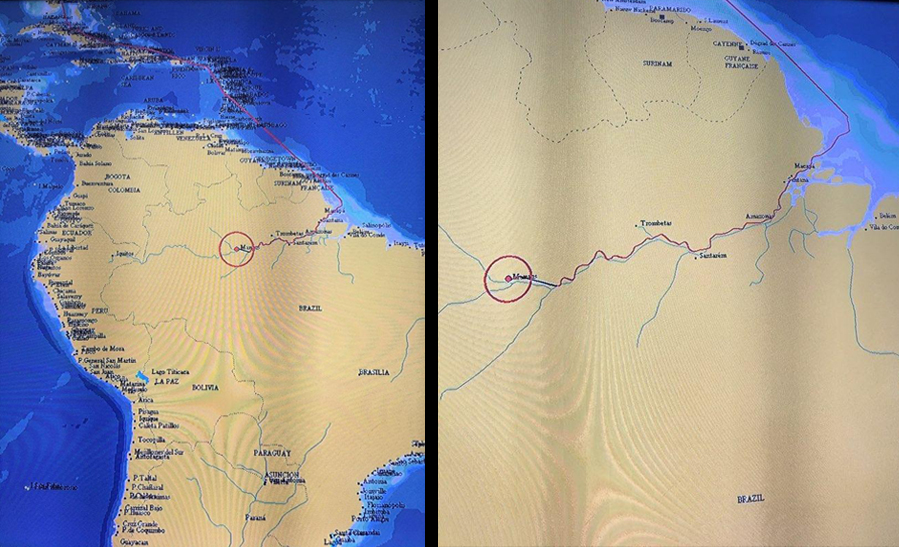
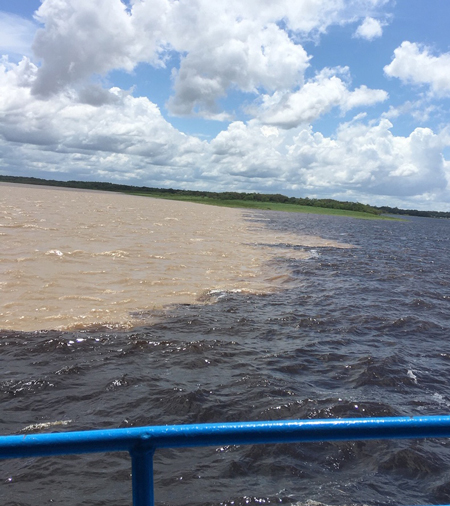
At Manaus, home of the rubber plantation boom prior to WW I, the Rio Negro and Solimoes come together. The area is called "the Meeting of the Waters." The rivers don't mix for about three miles. It is because of difference in temperature, ph, and density. The Negro is so acidic that mosquito larvae can't survive. We took a small boat out to the rivers meeting and then changed to a canoe to explore side channels.
The picture below was taken from Commodore Room located just above the bridge.
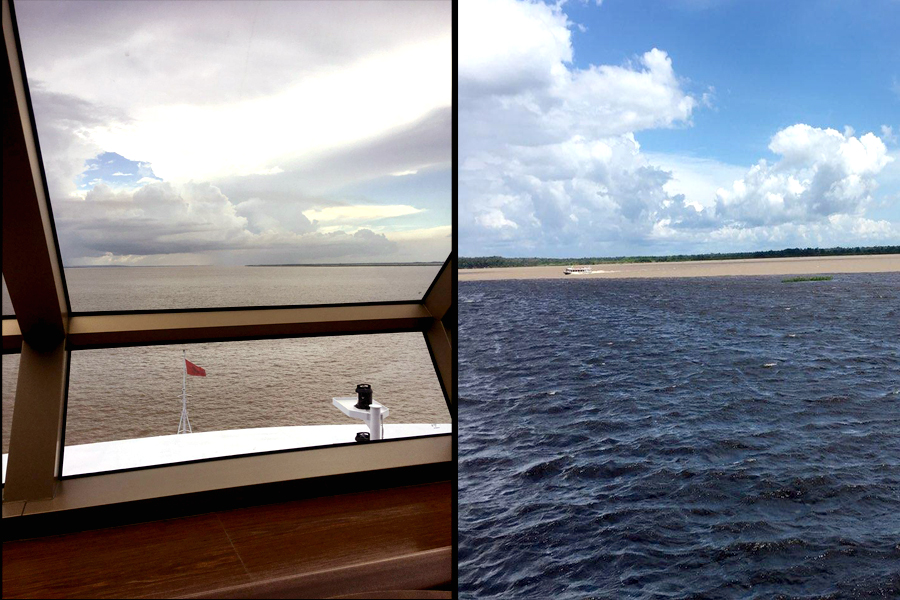
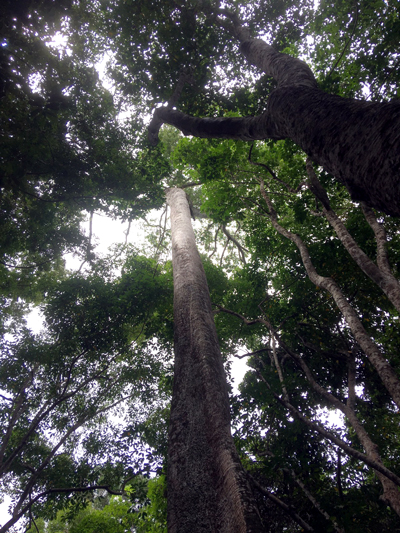
After a days cruising to Santarem we took a hike into the deep jungle. Our native guide did not speak English but our main guide could translate his tribal tongue. I have birded MS and LA swamps but the oppressive heat and humidity here along the equator was exceptional. The trees were massive and tall. It trapped a huge amount of hot air above us. It felt heavy.
Before the trip we decided not to get yellow fever and other shots. A letter from our doctor was accepted in every country. Our protection was clothing. I wore long thick cargo pants. a long sleeve shirt and my broad brimmed hat. I would spray the back of my head and ears. Neither one of us ever received an insect bite but it was a sweat fest.
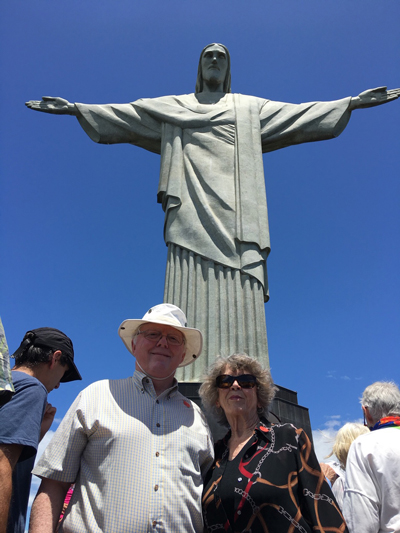
Continuing south we arrived at Rio for two days. Rio was what I expected. It deserved it's reputation for having a very beautiful harbor when pictured from the top of Corcovado Mountain ( Statue of Christ the Redeemer ) or Sugar loaf Mountain. We went to the top of both and drove by the beautiful beaches of Ipanema and Copacabana. The restaurant for lunch was special. A huge buffet of salads and side dishes and they came around with skewers of all kinds of meats. The rich lived behind walls, gates and guards. The poor areas were heart breaking. While we were warned of crime issues we did not have a problem.



Montevideo, Uruguay was the next port of call. We took a tour up the bay to Colonia del Sacramento. Both cities were neat and clean. People seemed happy and we were told that crime was not a big issue. It appeared that there was more middle class residents and less extreme poverty. Note that our tour guide could buy a house with a 9% mortgage.

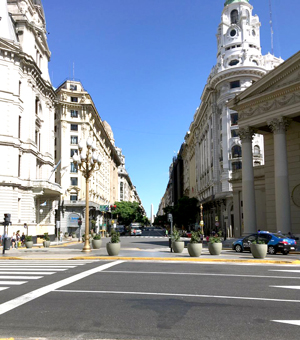 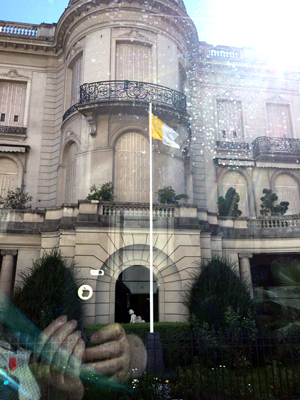 Buenos Aires, Argentina is right across the bay from Montevideo. It is called the Paris of South America and rightly so. The architecture of the public buildings in the central city is stunning. All around this center are apartments with equally spectacularly presence. Everything there is about 125 to 100 years old. New high rise condos are fenced and fences are now around the grand old apartment buildings. That is the problem. After a burst of glorious economic times Argentina has lost it's way. Inflation is 80% yearly. People are restricted in buying gold or converting their money to dollars. Our tour guide is saving to buy a house with a 37% mortgage. Crime is a big problem. Buenos Aires, Argentina is right across the bay from Montevideo. It is called the Paris of South America and rightly so. The architecture of the public buildings in the central city is stunning. All around this center are apartments with equally spectacularly presence. Everything there is about 125 to 100 years old. New high rise condos are fenced and fences are now around the grand old apartment buildings. That is the problem. After a burst of glorious economic times Argentina has lost it's way. Inflation is 80% yearly. People are restricted in buying gold or converting their money to dollars. Our tour guide is saving to buy a house with a 37% mortgage. Crime is a big problem.
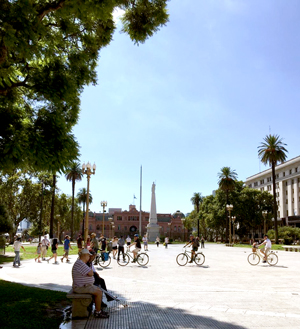 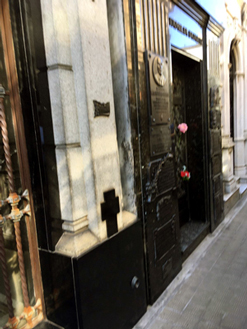
The reddish building with a balcony is at the end of a public square. It is where Evita spoke to the crowds. Lighting made a good picture impossible. Even here we were warned about muggers who would dart into the area and grab cameras etc. The dark doorway is were Evita was buried.
On our first night here we were treated by the ship to a banquet, gaucho rodeo and tango dance show.
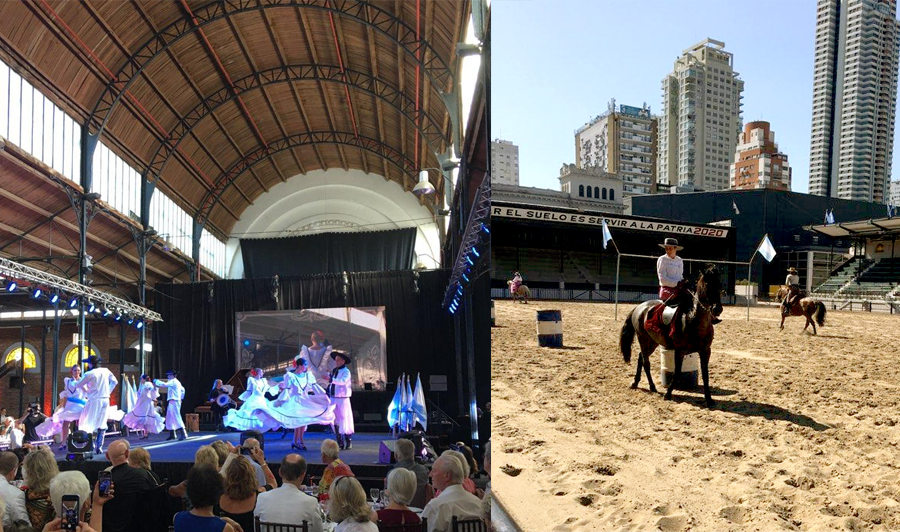
Just up the bay is an area called the Tigre Delta. It is like Venice or the bayou country of LA. It is a city of only canals. People live there full time and some city people have weekend homes. School kids are picked up by a boat and the grocery store is a boat that makes scheduled rounds.
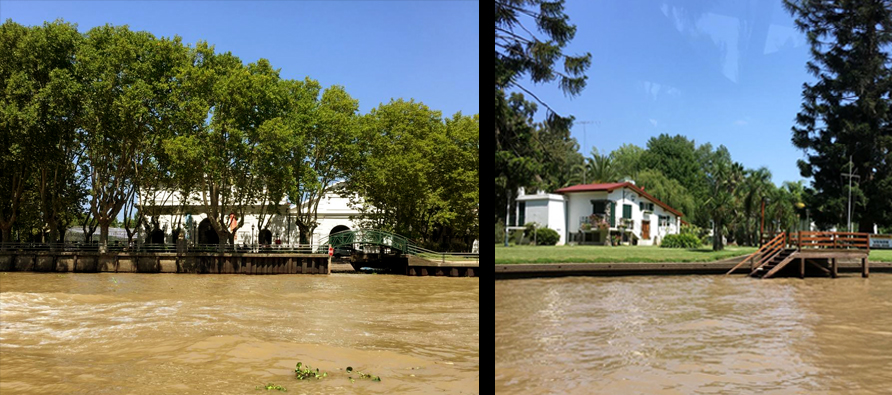
Five hundred new passengers got on board. They were going from Buenos Aires to San Antonio, Chile. There was no concern for the virus. This was February 15th.
 For the next two weeks the trip was all about nature. This bottom third of South America has very few inhabitants and is rich in wildlife. The ship also brought on board two nature commentators. I have birded over the years with a lot of experts and these guys were top notch. They were very patient and looked upon themselves as teachers. They each gave a one hour slide show presentation daily and at least one was always stationed on lookout. The ship broadcasts were now " whale...port side...two o'clock.. half way to horizon." Dusky dolphin, kelp gull, inca tern... you get the idea. I was in heaven. For the next two weeks the trip was all about nature. This bottom third of South America has very few inhabitants and is rich in wildlife. The ship also brought on board two nature commentators. I have birded over the years with a lot of experts and these guys were top notch. They were very patient and looked upon themselves as teachers. They each gave a one hour slide show presentation daily and at least one was always stationed on lookout. The ship broadcasts were now " whale...port side...two o'clock.. half way to horizon." Dusky dolphin, kelp gull, inca tern... you get the idea. I was in heaven.
The ship also brought on board as speaker a professional adventurer, Neil Laughton. He was a member of the team that attempted to climb Mount Everest in 1996 when a sudden storm trapped the group near the top. The book,"Into Thin Air," and a movie were made about that tragic day. He was in the lead at the time and came down a little with his partner to help. Among the team was a dentist that was presumed dead but the next morning he struggled back to camp with awful frost bite. In 1998 Neil reached the summit with partner, Bear Grylls of television fame. Neil gave talks on his adventures in Antarctica, Bering Sea, Iceland, deserts and more.
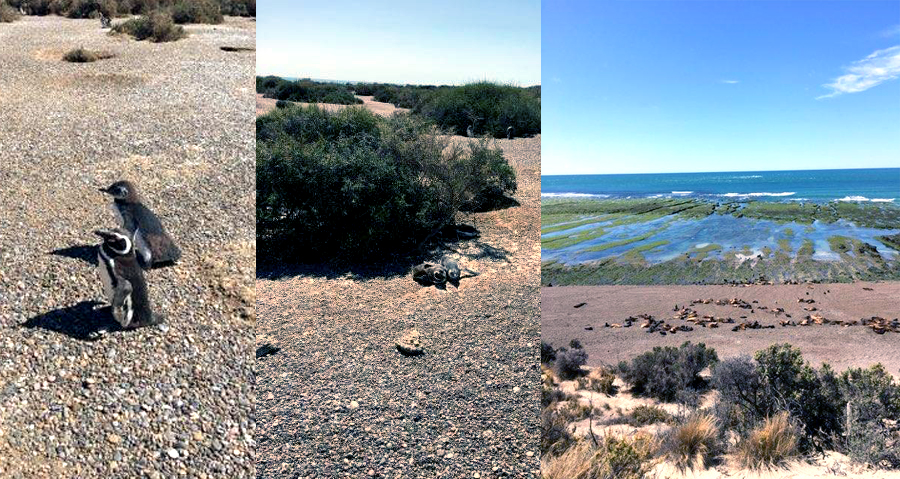
Next stop was Puerto Madyrn for penguins and sea lions.The port was in a bay and we had about a two hour bus ride to get to the end of the peninsula. This part of Argentina was in the Patagonia region of dry desert. Note how we could just walk among the 600,000 penguins in that area. We saw sea lions from the top of a cliff. This area is where orcas were first seen charging the beach to take sea lions and seals. We were there at low tide so not possible for us to see. Also it is not a daily occurrence. 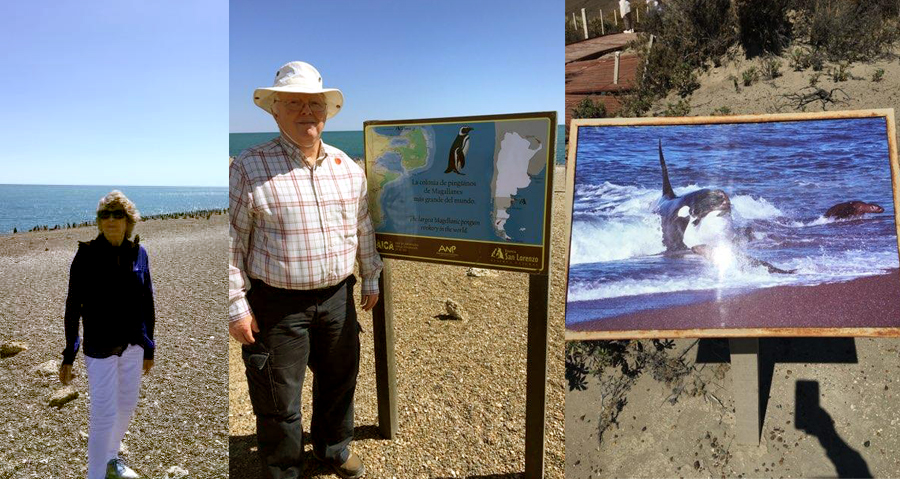
Between SA and the Falkland Islands we hit a major storm...thirty foot seas and 60 mph winds.It went on relentlessly for 18 hours. I was surprised how loud it was. We crashed into the wave with a loud bang and the whole ship would shudder. The wind would pick up the top curl of the wave and slam it onto the side of the ship. Many times it would smack our balcony.
We had to eat so we picked a route to the restaurant on the most narrow corridors. We bounced from side to side.Our cabin was near the front and our dinner table right at the aft window. A long walk in those conditions. The waiters were amazing with only a few spills and we ate a big meal.
No sea sickness for us . We are seasoned seafarers. Slept well after we got used to the rocking and noise. This storm was welcome because I wanted to be tested before rounding the sacred waters of Cape Horn.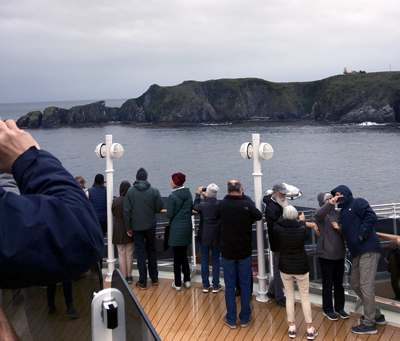
There are several maritime pros in the audience who might scoff at amateur swagger, especially from amateurs who get chocolates on their pillow every night. But I trust most are in awe:)
This is Cape Horn.The lighthouse is on the right. An estimated 800 ships and 10,000 men were lost here. We arrived four hours late because the storm slowed us down. Combination of clouds and late in the day made for a bad picture .But we had a nice view. Magellan rounded the cape in 1520. Mike and Billye in 2020.
| 


 The other couple was Steve(70) and Sue(72)...no joke. They were from England. She was in banking. He ran the farm that had been in the family for multi generations. They live in the original farm house that was built in 1610. It is a cute little two story cottage built of stone. About 30 years ago they added a one story kitchen and an office area on either side. The original root cellar is still used for keeping their food cool.
Steve raises cattle and sheep. Grass fed. No chemicals used anywhere so they have a very sought after organic product. He takes his livestock to a specialty slaughter house where it is sold to high end London restaurants. He is just a good old boy. He can do plumbing, electrical, welding and a lot of veterinary stuff himself. All his fences are made of stone. If they need repair you just don't pile on stones. I learned there is a science to it. They are like us and have just started cruising in the last three years. All Cunard ships.
The other couple was Steve(70) and Sue(72)...no joke. They were from England. She was in banking. He ran the farm that had been in the family for multi generations. They live in the original farm house that was built in 1610. It is a cute little two story cottage built of stone. About 30 years ago they added a one story kitchen and an office area on either side. The original root cellar is still used for keeping their food cool.
Steve raises cattle and sheep. Grass fed. No chemicals used anywhere so they have a very sought after organic product. He takes his livestock to a specialty slaughter house where it is sold to high end London restaurants. He is just a good old boy. He can do plumbing, electrical, welding and a lot of veterinary stuff himself. All his fences are made of stone. If they need repair you just don't pile on stones. I learned there is a science to it. They are like us and have just started cruising in the last three years. All Cunard ships.









 Buenos Aires, Argentina is right across the bay from Montevideo. It is called the Paris of South America and rightly so. The architecture of the public buildings in the central city is stunning. All around this center are apartments with equally spectacularly presence. Everything there is about 125 to 100 years old. New high rise condos are fenced and fences are now around the grand old apartment buildings. That is the problem. After a burst of glorious economic times Argentina has lost it's way. Inflation is 80% yearly. People are restricted in buying gold or converting their money to dollars. Our tour guide is saving to buy a house with a 37% mortgage. Crime is a big problem.
Buenos Aires, Argentina is right across the bay from Montevideo. It is called the Paris of South America and rightly so. The architecture of the public buildings in the central city is stunning. All around this center are apartments with equally spectacularly presence. Everything there is about 125 to 100 years old. New high rise condos are fenced and fences are now around the grand old apartment buildings. That is the problem. After a burst of glorious economic times Argentina has lost it's way. Inflation is 80% yearly. People are restricted in buying gold or converting their money to dollars. Our tour guide is saving to buy a house with a 37% mortgage. Crime is a big problem. 




 For the next two weeks the trip was all about nature. This bottom third of South America has very few inhabitants and is rich in wildlife. The ship also brought on board two nature commentators. I have birded over the years with a lot of experts and these guys were top notch. They were very patient and looked upon themselves as teachers. They each gave a one hour slide show presentation daily and at least one was always stationed on lookout. The ship broadcasts were now " whale...port side...two o'clock.. half way to horizon." Dusky dolphin, kelp gull, inca tern... you get the idea. I was in heaven.
For the next two weeks the trip was all about nature. This bottom third of South America has very few inhabitants and is rich in wildlife. The ship also brought on board two nature commentators. I have birded over the years with a lot of experts and these guys were top notch. They were very patient and looked upon themselves as teachers. They each gave a one hour slide show presentation daily and at least one was always stationed on lookout. The ship broadcasts were now " whale...port side...two o'clock.. half way to horizon." Dusky dolphin, kelp gull, inca tern... you get the idea. I was in heaven. 

